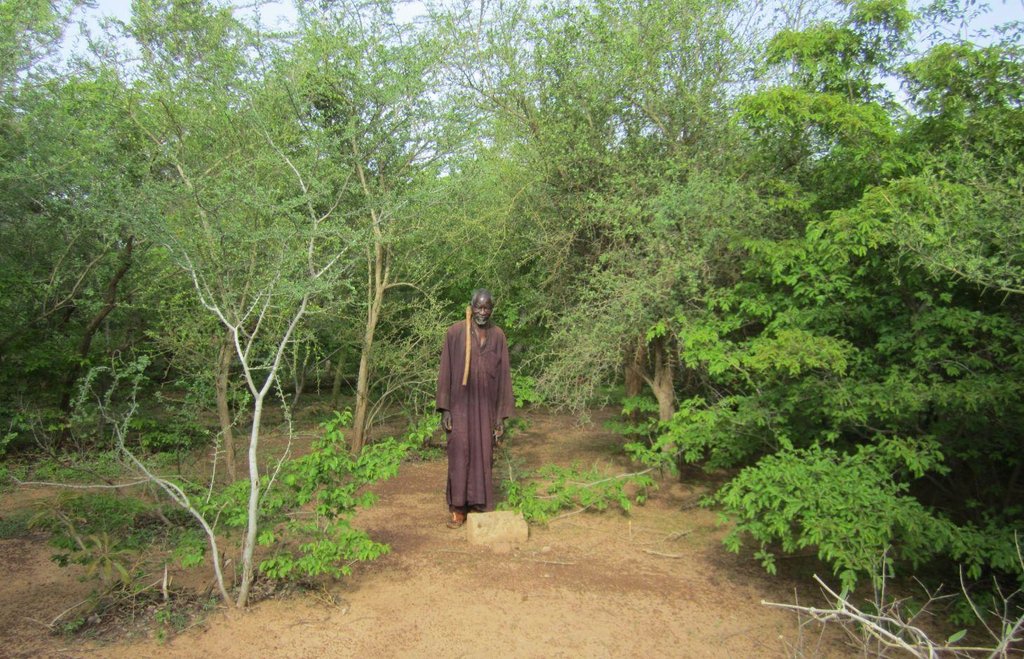Zaï forestier [Burkina Faso]
- Creation:
- Update:
- Compiler: Sounkali SERME
- Editor: –
- Reviewer: Deborah Niggli
Tissé zaï (mooré)
technologies_1182 - Burkina Faso
View sections
Expand all Collapse all1. General information
1.2 Contact details of resource persons and institutions involved in the assessment and documentation of the Technology
SLM specialist:
SLM specialist:
Kini Janvier
flavki@yahoo.fr
Université de Ouagadougou
BP 7164, Ouagadougou
Burkina Faso
Name of the institution(s) which facilitated the documentation/ evaluation of the Technology (if relevant)
INERA Institut de l'environnement et de recherches agricoles (INERA Institut de l'environnement et de recherches agricoles) - Burkina Faso1.3 Conditions regarding the use of data documented through WOCAT
When were the data compiled (in the field)?
25/08/2013
The compiler and key resource person(s) accept the conditions regarding the use of data documented through WOCAT:
Yes
1.4 Declaration on sustainability of the described Technology
Is the Technology described here problematic with regard to land degradation, so that it cannot be declared a sustainable land management technology?
No
2. Description of the SLM Technology
2.1 Short description of the Technology
Definition of the Technology:
Les zaï forestier est une technique de réhabilitation des terres dans le but de régénérer la végétation.
2.2 Detailed description of the Technology
Description:
La technique consiste à creuser des trous de 1 m de diamètre et de 50 à 70 cm de profondeur dans lesquels on met de la matière organique et on y plante des arbres en hivernage. Il est l’œuvre d’un paysan innovateur Yacouba Sawadogo
L’objectif est de régénérer la couverture végétale et de réhabiliter la terre en collectant des eaux de ruissellement pendant l'hivernage et la saison sèche. La technique vise aussi à lutter contre la désertification et de réintroduire des espèces disparues et utilitaires en disparition notamment dans le domaine de la pharmacopée.
Les trous sont creusés à l’aide de pic-à-axe et de barre à mine. La terre excavée entièrement et la fumure organique produite dans la fosse fumière est introduite en raison de 5 pelletées (variables selon l’espèce). Les graines sont semées dans le trou (pas des plants à partir d’une pépinière). Il est pratiqué sur des sols de type latéritique, gravillonnaire ou dénudé.
Il faut beaucoup surveiller le plant afin d’éviter qu’il soit mangé par les termites ainsi que des animaux. Les intrants sont constitués essentiellement des semences des espèces ligneuses à régénérer ainsi que de la main d’œuvre, la matière organique, le petit équipement (pelle, brouette, pic-à-ace, baril). NB : l’exploitant de la technologie a un forage sur les lieux.
Il faut un sol latérite gravillonnaire ou dénudé. Le travail est individuel mais nécessite une main d’œuvre importante.
2.3 Photos of the Technology
2.5 Country/ region/ locations where the Technology has been applied and which are covered by this assessment
Country:
Burkina Faso
Region/ State/ Province:
Burkina Faso / Yatenga
Further specification of location:
Nord /Ouahigouya
Map
×2.6 Date of implementation
If precise year is not known, indicate approximate date:
- less than 10 years ago (recently)
2.7 Introduction of the Technology
Specify how the Technology was introduced:
- through land users' innovation
Comments (type of project, etc.):
L’expérimentation a commencé en 1985 et est encore au stade d’un seul individu
3. Classification of the SLM Technology
3.1 Main purpose(s) of the Technology
- reduce, prevent, restore land degradation
- conserve ecosystem
3.2 Current land use type(s) where the Technology is applied

Mixed (crops/ grazing/ trees), incl. agroforestry
- Agro-pastoralism
Comments:
Problèmes principaux: Erosion des sols (apparition des rigoles et des ravines), une baisse notable de la fertilité des terres (Zippela) et une disparition de la végétation. Ruissellements intenses lors de fortes pluies. Absence d’herbes (fourrages) pour les animaux. Baisse des rendements des cultures. Baisse des rendements des cultures, insuffisance de fourrages; Érosion des sols (apparition des rigoles et des ravines), manque de terres de bonne qualité.
3.3 Further information about land use
Water supply for the land on which the Technology is applied:
- mixed rainfed-irrigated
Number of growing seasons per year:
- 1
Livestock density (if relevant):
50-100 LU /km2
3.4 SLM group to which the Technology belongs
- natural and semi-natural forest management
- improved ground/ vegetation cover
3.5 Spread of the Technology
Specify the spread of the Technology:
- evenly spread over an area
If the Technology is evenly spread over an area, indicate approximate area covered:
- 0.1-1 km2
Comments:
0,1 m2. C'est une technologie traditionnelle de régénération de la végétation par le zaï.
3.6 SLM measures comprising the Technology

agronomic measures
- A1: Vegetation/ soil cover

vegetative measures
- V1: Tree and shrub cover

structural measures
- S4: Level ditches, pits

management measures
- M5: Control/ change of species composition
Comments:
Type of agronomic measures: manure / compost / residues, pits
Type of vegetative measures: scattered / dispersed
3.7 Main types of land degradation addressed by the Technology

biological degradation
- Bc: reduction of vegetation cover
Comments:
Causes de dégradation: soil management, crop management (annual, perennial, tree/shrub), deforestation / removal of natural vegetation (incl. forest fires), change of seasonal rainfall, droughts, population pressure, over-exploitation of vegetation for domestic use, overgrazing, industrial activities and mining, change in temperature, wind storms / dust storms, poverty / wealth, labour availability, inputs and infrastructure: (roads, markets, distribution of water points, other, …), education, access to knowledge and support services, governance / institutional
3.8 Prevention, reduction, or restoration of land degradation
Specify the goal of the Technology with regard to land degradation:
- prevent land degradation
- restore/ rehabilitate severely degraded land
4. Technical specifications, implementation activities, inputs, and costs
4.1 Technical drawing of the Technology
4.2 Technical specifications/ explanations of technical drawing
Schéma du zaï forestier
Location: Gourga. Nord/Yatenga/Ouahigouya
Date: 04/08/2014
Technical knowledge required for field staff / advisors: high
Technical knowledge required for land users: high
Main technical functions: control of dispersed runoff: retain / trap, control of concentrated runoff: retain / trap, improvement of ground cover, stabilisation of soil (eg by tree roots against land slides), increase in organic matter, increase in nutrient availability (supply, recycling,…), increase / maintain water stored in soil, sediment retention / trapping, sediment harvesting, increase of biomass (quantity), promotion of vegetation species and varieties (quality, eg palatable fodder)
Secondary technical functions: control of raindrop splash, control of dispersed runoff: impede / retard, control of concentrated runoff: impede / retard, increase of infiltration, reduction in wind speed
Manure / compost / residues
Material/ species: Compost dans les poquets
Quantity/ density: 10
Remarks: en tonnes par hectare
Pits
Material/ species: creusage de gros poquet de zaï
Quantity/ density: 2400
Remarks: trous par hectare
Scattered / dispersed
Vegetative material: F : fruit trees / shrubs
Number of plants per (ha): 2400
Spacing between rows / strips / blocks (m): 3
Width within rows / strips / blocks (m): 3
Trees/ shrubs species: acacia albida, combretum, guiera
Fruit trees / shrubs species: raisinier, baobab, prunier
Grass species: andropogon, pennicetum
Retention/infiltration ditch/pit, sediment/sand trap
Vertical interval between structures (m): 5
Spacing between structures (m): 3
Depth of ditches/pits/dams (m): 0.75
Width of ditches/pits/dams (m): 1
Construction material (earth): Terre extraite des fossés et utilisée pour la construction des diguettes
Construction material (stone): le fossé de drainage est délimité par des pierres, digue de pierres
Slope (which determines the spacing indicated above): 1 à 3%
Vegetation is used for stabilisation of structures.
4.3 General information regarding the calculation of inputs and costs
other/ national currency (specify):
Franc CFA
Indicate exchange rate from USD to local currency (if relevant): 1 USD =:
500.0
Indicate average wage cost of hired labour per day:
8.00
4.4 Establishment activities
| Activity | Type of measure | Timing | |
|---|---|---|---|
| 1. | Trouaison | Vegetative | Saison sèche |
| 2. | Trouaison | Structural | saison sèche |
4.5 Costs and inputs needed for establishment
| Specify input | Unit | Quantity | Costs per Unit | Total costs per input | % of costs borne by land users | |
|---|---|---|---|---|---|---|
| Labour | main d'oevre | ha | 1.0 | 120.0 | 120.0 | 100.0 |
| Equipment | tools | ha | 1.0 | 96.8 | 96.8 | 100.0 |
| Fertilizers and biocides | fertilizer | ha | 1.0 | 100.0 | 100.0 | 100.0 |
| Total costs for establishment of the Technology | 316.8 | |||||
Comments:
Duration of establishment phase: 2 month(s)
4.6 Maintenance/ recurrent activities
| Activity | Type of measure | Timing/ frequency | |
|---|---|---|---|
| 1. | Surveillance des plants | Vegetative | annuel |
4.7 Costs and inputs needed for maintenance/ recurrent activities (per year)
| Specify input | Unit | Quantity | Costs per Unit | Total costs per input | % of costs borne by land users | |
|---|---|---|---|---|---|---|
| Labour | main d'oevre | ha | 1.0 | 10.0 | 10.0 | 100.0 |
| Equipment | tools | ha | 1.0 | 5.0 | 5.0 | 100.0 |
| Total costs for maintenance of the Technology | 15.0 | |||||
Comments:
Machinery/ tools: pic-à-casse, barre à mine, charrette, brouette.
4.8 Most important factors affecting the costs
Describe the most determinate factors affecting the costs:
Le coût de la main d’œuvre, de l’équipement nécessaire ainsi que le coût de la fumure constituent les principaux déterminants des coûts de mise en œuvre de cette technologie.
5. Natural and human environment
5.1 Climate
Annual rainfall
- < 250 mm
- 251-500 mm
- 501-750 mm
- 751-1,000 mm
- 1,001-1,500 mm
- 1,501-2,000 mm
- 2,001-3,000 mm
- 3,001-4,000 mm
- > 4,000 mm
Agro-climatic zone
- semi-arid
Thermal climate class: tropics. car tous les mois sont au dessus de 18°C
5.2 Topography
Slopes on average:
- flat (0-2%)
- gentle (3-5%)
- moderate (6-10%)
- rolling (11-15%)
- hilly (16-30%)
- steep (31-60%)
- very steep (>60%)
Landforms:
- plateau/plains
- ridges
- mountain slopes
- hill slopes
- footslopes
- valley floors
Altitudinal zone:
- 0-100 m a.s.l.
- 101-500 m a.s.l.
- 501-1,000 m a.s.l.
- 1,001-1,500 m a.s.l.
- 1,501-2,000 m a.s.l.
- 2,001-2,500 m a.s.l.
- 2,501-3,000 m a.s.l.
- 3,001-4,000 m a.s.l.
- > 4,000 m a.s.l.
5.3 Soils
Soil depth on average:
- very shallow (0-20 cm)
- shallow (21-50 cm)
- moderately deep (51-80 cm)
- deep (81-120 cm)
- very deep (> 120 cm)
Soil texture (topsoil):
- coarse/ light (sandy)
Topsoil organic matter:
- low (<1%)
5.4 Water availability and quality
Ground water table:
5-50 m
Availability of surface water:
poor/ none
Water quality (untreated):
for agricultural use only (irrigation)
5.5 Biodiversity
Species diversity:
- high
5.6 Characteristics of land users applying the Technology
Market orientation of production system:
- subsistence (self-supply)
- mixed (subsistence/ commercial
Off-farm income:
- less than 10% of all income
Relative level of wealth:
- poor
- average
Gender:
- men
Indicate other relevant characteristics of the land users:
Difference in the involvement of women and men: Manque de main d’œuvre et de temps pour les femmes
Population density: 50-100 persons/km2
Annual population growth: 2% - 3%
1% of the land users are very rich.
1% of the land users are rich.
50% of the land users are average wealthy.
45% of the land users are poor.
3% of the land users are poor.
Off-farm income specification: transferts reçus, l’artisanat, le commerce...
Market orientation of production system: Pharmacopée
5.7 Average area of land owned or leased by land users applying the Technology
- < 0.5 ha
- 0.5-1 ha
- 1-2 ha
- 2-5 ha
- 5-15 ha
- 15-50 ha
- 50-100 ha
- 100-500 ha
- 500-1,000 ha
- 1,000-10,000 ha
- > 10,000 ha
Is this considered small-, medium- or large-scale (referring to local context)?
- small-scale
5.8 Land ownership, land use rights, and water use rights
Land ownership:
- state
- communal/ village
Land use rights:
- individual
Water use rights:
- individual
Comments:
les terres agricoles ne se vendent pas alors que l’eau est librement accessible à tous
5.9 Access to services and infrastructure
health:
- poor
- moderate
- good
education:
- poor
- moderate
- good
technical assistance:
- poor
- moderate
- good
employment (e.g. off-farm):
- poor
- moderate
- good
markets:
- poor
- moderate
- good
energy:
- poor
- moderate
- good
roads and transport:
- poor
- moderate
- good
drinking water and sanitation:
- poor
- moderate
- good
6. Impacts and concluding statements
6.1 On-site impacts the Technology has shown
Socio-economic impacts
Production
crop production
fodder production
fodder quality
animal production
wood production
production area
land management
Water availability and quality
demand for irrigation water
Income and costs
expenses on agricultural inputs
farm income
diversity of income sources
workload
Socio-cultural impacts
health situation
contribution pour le bien-être
Comments/ specify:
Car l’accroissement de la production d’arbres engendre un accroissement de revenu forestier permettant d’accéder à ces services sociaux de base. Cela contribue à combler les déficits
Ecological impacts
Water cycle/ runoff
harvesting/ collection of water
surface runoff
evaporation
Soil
soil moisture
soil cover
soil loss
soil compaction
nutrient cycling/ recharge
soil organic matter/ below ground C
Biodiversity: vegetation, animals
biomass/ above ground C
plant diversity
animal diversity
beneficial species
habitat diversity
Climate and disaster risk reduction
emission of carbon and greenhouse gases
wind velocity
6.2 Off-site impacts the Technology has shown
wind transported sediments
6.3 Exposure and sensitivity of the Technology to gradual climate change and climate-related extremes/ disasters (as perceived by land users)
Gradual climate change
Gradual climate change
| Season | Type of climatic change/ extreme | How does the Technology cope with it? | |
|---|---|---|---|
| annual temperature | increase | well |
Climate-related extremes (disasters)
Meteorological disasters
| How does the Technology cope with it? | |
|---|---|
| local rainstorm | not well |
| local windstorm | not known |
Climatological disasters
| How does the Technology cope with it? | |
|---|---|
| drought | not well |
Hydrological disasters
| How does the Technology cope with it? | |
|---|---|
| general (river) flood | not known |
Other climate-related consequences
Other climate-related consequences
| How does the Technology cope with it? | |
|---|---|
| reduced growing period | not well |
6.4 Cost-benefit analysis
How do the benefits compare with the establishment costs (from land users’ perspective)?
Short-term returns:
very positive
Long-term returns:
very positive
How do the benefits compare with the maintenance/ recurrent costs (from land users' perspective)?
Short-term returns:
very positive
Long-term returns:
very positive
Comments:
Car les exploitants investissent toujours lorsque le résultat est positif
6.5 Adoption of the Technology
- 10-50%
Comments:
C’est un seul exploitant qui expérimente la technologie pour l’heure. Mais au regard des résultats, elle fera tache d’huile sur la population dans son ensemble. Il bénéficie d’un appui externe allemand (forage construit sur l’exploitation).
En fin 2013, 8 exploitants ont réalisé le zaï forestier dans la zone.
There is a little trend towards spontaneous adoption of the Technology
Comments on adoption trend: en 2013, 8 nouveaux exploitants sont entrain d’expérimenter la technologie.
6.7 Strengths/ advantages/ opportunities of the Technology
| Strengths/ advantages/ opportunities in the land user’s view |
|---|
| La technologie de zaï forestier permet d'augmenter la diversité végétale |
| La technologie de zaï forestier permet de favoriser la disponibilité accrue en bois |
| La technologie de zaï forestier permet la possibilité d’accroître l’offre de soins traditionnels |
| La technologie de zaï forestier permet d'accroitre la source de bois de feu |
| Strengths/ advantages/ opportunities in the compiler’s or other key resource person’s view |
|---|
| La technologie de zaï forestier permet d'augmenter les espèces végétales |
| La technologie de zaï forestier permet d'augmenter les rendements en bois |
| La technologie de zaï forestier permet d'augmenter les revenus forestiers |
6.8 Weaknesses/ disadvantages/ risks of the Technology and ways of overcoming them
| Weaknesses/ disadvantages/ risks in the land user’s view | How can they be overcome? |
|---|---|
| L'utilisation plus importante de la main-d’œuvre constitue un frein à la réalisation du zaï forestier | L'utilisation de la mécanisation peut aider à réduire la main-d’œuvre |
| L'insuffisance de moyens financiers est aussi un frein au zaï forestier | Une subvention et des crédits en moyen matériels peut aider à obtenir de meilleurs résultats |
| La divagation des animaux ne permet pas de réussir le zaï forestier | La construction des lieux de pâture peut aider à limiter le dégât des animaux |
| Les problèmes fonciers limitent considérablement la réalisation de la technologie du zaï forestier | il est nécessaire de veiller à la sécurisation foncière afin de profiter du za¨forestier |
| Weaknesses/ disadvantages/ risks in the compiler’s or other key resource person’s view | How can they be overcome? |
|---|---|
| L'utilisation plus importante de la main-d’œuvre constitue un frein à la réalisation du zaï forestier | L'utilisation de la mécanisation peut aider à réduire la main-d’œuvre |
| L'insuffisance de moyens financiers est aussi un frein au zaï forestier | Une subvention et des crédits en moyen matériels peut aider à obtenir de meilleurs résultats |
| La divagation des animaux ne permet pas de réussir le zaï forestier | La construction des lieux de pâture peut aider à limiter le dégât des animaux |
| Les problèmes fonciers limitent considérablement la réalisation de la technologie du zaï forestier | il est nécessaire de veiller à la sécurisation foncière afin de profiter du za¨forestier |
7. References and links
7.1 Methods/ sources of information
- field visits, field surveys
- interviews with land users
Links and modules
Expand all Collapse allLinks
No links
Modules
No modules








